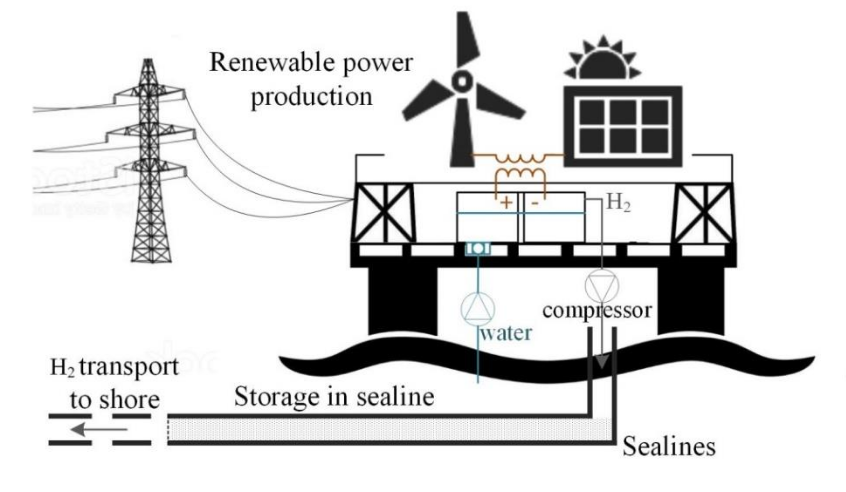BlueMed StartUP Action SEALINES publishes its feasibility plan on the re-use of offshore infrastructures for energy transition
The BlueMed Start Up Action SEALINES has recently published its final outcome: the feasibility study for a scientific research hub on an integrated green energy system.

The StartUp Action focused on assessing the viability of repurposing a decommissioned offshore platform in order to generate green energy. The study proposes to combine solar panels, wind turbines and wave energy production system to generate the electric power sufficient to elctrolyse water and produce hydrogen, which would be afterwards conveyed to the existing gas sealine of the nearby platforms in operation and sold at the same price of the natural gas.
The SEALINES BlueMed StartUp (Mediterranean Safety Network) was coordinated by Ilaria Antoncecchi (Ministry of Economic Development/Bicocca University of Milan, Italy) and co-lead by Marco Pacini (Rossetti Marino SpA, Italy), and worked with partners from Egypt, Greece, Tunisia, Italy, Croatia and Cyprus.
In the following, the executive summary of the feasiblity study drafted by SEALINES.
Executive summary
This feasibility study represents the outcome of the multi-disciplinary approach of Sealines Start-up Action, createdby thestrong interaction at international level between research centers, stakeholders, and policy makers to achieve results for blue growth according to Research Strategic Agenda goals.
With this aims, the feasibility study considers an abandoned platform, otherwise decommissioned, as the best case to test a hub for scientific research on an integrated “green energy” system.
AZALEA A, as one of the platforms that in Italian regulatory framework is available for repurposing projects (see Official Italian Hydrocarbon and Georesources Bulletin, BUIG of August 2019), was chosen as a real case study because its features fit reasonably well to run a demo that may be later apply to other cases.
Given a small description of the Start-up Action initiative, the document provides more elements about the project idea and lists AZALEA A technical features: position, structural status, linked facilities. The energy potential from renewable resources (wind, solar, wave) is evaluated from literature data. The study proposes the installation of solar panel, wind turbine and wave energy production systems. 100% of the electric power produced by photovoltaic and/or turbine systems and/or wave systems may feed the electrolyzer and may be converted to produce H2 thanks to the use of Proton Exchange Membranes –PEM.Once a green energy is produced and converted in H2 also a possible transport system needs to be evaluated. For this reason, the feasibility study investigates a repurposing process involving linked sealines as well.
Two different options are contemplated: energy inland transport and H2 storage and transport. Three ideal business cases associated to this project idea have been studied to identify the budgetary investment costs:
−option 1: hybrid electric power generation integrated into the power system of the nearby platforms in operation (it is not the option linked to case studyof AZALEAA);
– option 2: direct H2 injection into the existing gas sealine of the nearby platforms in operation and sold at the same price of the natural gas (same case of AZALEAA);
−option 3: inland transportation through abandoned sealine and sold as H2technical gas (it is not the option linked to case study of AZALEAA).
Referring to the second option the same case of AZALEA A considering the power generation of 270,000 kWh/year by solar and wind, and H2 injection into the existing natural gas sealines a total investment costs is estimated about 0.8million of euro. Although the amount of renewable sources estimated in the study area (as definedby literature) may notbe enough for an economic investment in the current economic frame, the use of existing offshore infrastructure for power generation, included the reuse of sealines for energy storage and transport of H2, seems to be a good solution from an economic point of view considering decommissioning costs.
Furthermore, the results from the analysis of reuse of existing sealines for hydrogen storage and transport highlight the possibility to store hydrogen until 1,852 kg at maximum pressure of 330 bar (considering the safety threshold defined by API standards). The proposed technical study demonstrates how the integration of the existing offshore infrastructures with the new hybrid power generation systems is feasible and can be envisaged as a positive example of “Blue Economy”. However, it is important at this stage to test the technological and scientific improvements. A further scale-up of the SEALINES Start-up Action may provide a good solution proposing a scientific research hub andan integrated green energy system on a disused platform. In this case also innovative methods to ensure the proper monitoring activities of both platform structural integrity (existing structures to evaluate the health state and their usability, for their re-use in several scenarios) as well as the environmental aspectswill be carefullyinvestigated. In addition, the current existing gapsin common best practices on the matter will be studied and suggestions for improvement will be proposed, where possible.
(cover image by Jonathan Jordan, CC-BY license)
